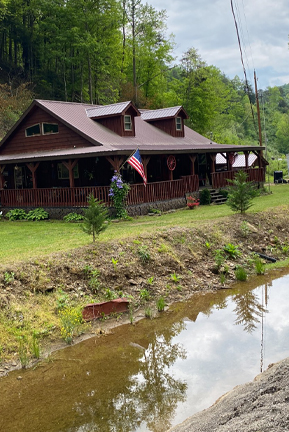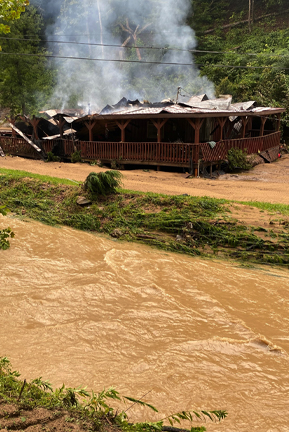
The Path Forward for Communities Like Lost Creek
Carl Asher clung to a wooden post on his porch for three hours—yelling for help in the darkness, water lapping at his neck —before risking it all.
He threw himself into the torrent below and, guided by a neighbor’s spotlight, swam several hundred feet against a punishing current to high ground. Asher and his wife, Tonya, a member of the United Steelworkers (USW) who was at work at the time, lost their home, five vehicles, a camper, and their 12-year-old cat, Ebony, in historic flooding that killed 39 and obliterated parts of Eastern Kentucky in July.
Climate change rendered these communities and countless others across the country vulnerable to increasingly frequent and powerful storms.
The nation long responded to these calamities with patchwork repairs that failed to provide lasting improvements or real protection. But now, America’s $1.2 trillion Infrastructure Investment and Jobs Act (IIJA) is delivering the stronger, more resilient roads, broadband networks and water systems that comprehensively guard against not only floods but wildfires, tornadoes, hurricanes and other disasters.
The IIJA, which President Joe Biden signed in November, earmarks billions for flood prevention and mitigation projects alone. That includes shoring up dilapidated dams, strengthening coastal defenses, overhauling the stormwater systems needed to manage heavy rains, relocating drinking water lines out of flood zones and upgrading sewer systems to prevent the overflows that occur during major storms.
And the IIJA includes funds for dredging long-neglected waterways, while also allocating hundreds of millions of dollars more each year to a program that elevates homes in at-risk areas so that others will be spared what the Ashers and other Kentuckians endured this summer.
The couple, longtime residents of the small community called Lost Creek, completed a screened-in porch and a concrete driveway and added to a memory garden dedicated to their late son, Matthew, in the months before the flood.
The water rose so rapidly that night that Carl Asher dropped a box of valuables he had gathered and shimmied up the porch for safety. The flood eventually triggered a fire, which caused the second floor to collapse into the first and ended any hope of saving their home of 16 years.
“If I was there, I would not have survived. I cannot swim. I would not have made it,” said Tonya Asher, a member of USW Local 14637 who works at the Appalachian Regional Healthcare medical center in nearby Hazard, Ky., noting the current her husband battled was so strong it “literally ripped his clothes off of him. By the time he reached the neighbors, he was just shaking.”
In a report last year, the American Society of Civil Engineers gave poor grades to Kentucky’s infrastructure. The flooding “annihilated” much of what remained in 13 counties, wiping out roads and bridges and knocking out power, cell phone and internet service at a time residents needed them most.
“You’d go to an address, and there was nothing there,” said Gypsy Cantrell, president of USW Local 14581 in Elkhorn City, Ky., recalling how the city of Hazard looked on a day she delivered supplies to fellow union members who lost all they had. “It was in such a state you couldn’t tell what street you were on.”
“So much contributed to this,” said Cantrell, who also started a Facebook page and helped to raise thousands of dollars for disaster victims. “The creeks and the small rivers, they’ve never been dredged. They are doing some now as they clean up the flood debris.”
Many Local 14581 members are highly skilled construction workers who have been volunteering their time to help USW brothers and sisters devastated by the flooding. They’ve also remained on the job, aiding government agencies in clearing debris, making temporary stream crossings and reopening communities.
In coming months, Cantrell expects those workers will return to the larger task of building the new, tougher roads, bridges, water systems and other infrastructure upgrades set in motion by the IIJA. Those projects will leave Lost Creek and similar communities stronger than before.
“That’s the objective here,” Biden said while inspecting the damage in Lost Creek last month.
“It’s not just to get back to where we were. It’s to get back to better than where we were, and we have the wherewithal to do it now,” Biden added, noting improvements to communication networks and internet service also will be part of rebuilding efforts through the IIJA.
If a community installs a new water line, he pointed out, “there’s no reason why they can’t at the same time be digging a line that puts in a whole new modern line for internet connections.”
The USW helped to push the IIJA through Congress because it will sustain millions of good-paying union jobs and take the expansive, holistic steps needed to move the nation forward. The infrastructure program will touch almost every aspect of American life.
Just as essential as new roads and bridges, for example, are the IIJA’s historic investments in rail, airports and inland navigation to ensure the flow of commerce and enhance the nation’s global competitiveness.
The billions targeted for wind, solar and hydrogen energy will grow and diversify America’s power supplies, enhancing national security. And new schools will provide the modern facilities all students need to lead productive lives.
Cantrell said Eastern Kentucky’s rugged topography long hindered infrastructure development there. But now, the IIJA provides the resources—and commitment—essential to giving the people in her region a brighter future.
“It will help us get ahead,” she said. “But we have to catch up first.”
*
Photos of the Ashers’ home before and after the flood
By clicking Sign Up you're confirming that you agree with our Terms and Conditions.
Related Blogs
Ready to make a difference?
Are you and your coworkers ready to negotiate together for bigger paychecks, stronger benefits and better lives?

